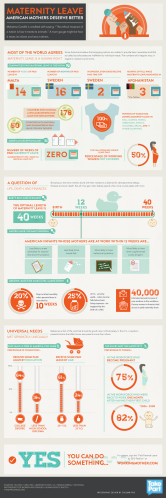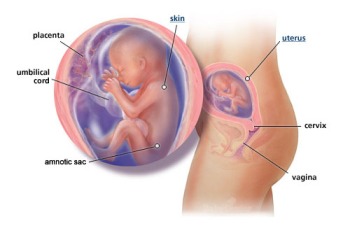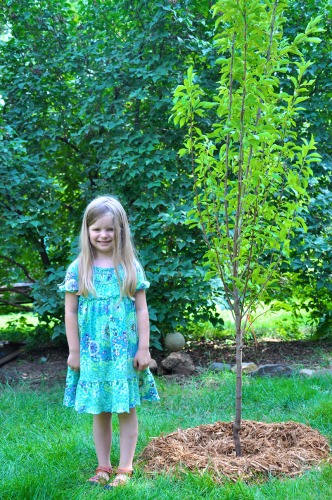Hilary Duff gives birth!

After announcing her pregnancy in August 2011, Hilary gave birth to a 7 lb. 6 oz. baby boy named Luca Cruz on the evening of Tuesday, March 20th. She posted on her blog: “We are overjoyed and feel like the luckiest parents in the world. He is surrounded by so much love!! Mom and baby are both doing extremely well.”, later tweeting “4am… sleepy eyed. Feeding baby… whew this job is no joke!”
“The Second Nine Months: Exterogestation and the Need To Be Held” – via Boba Family
I think this reading is vital for everyone, but especially mothers and fathers to-be. In fact, I see it as basic information that should be taught along with sex ed and/or childbirth education. It saddens me that most of us know so little about infant care and are instead bombarded with information on strollers and pacifiers instead of what babies truly need from us as parents and caregivers.
Male newborn circumcision rate falls to its lowest level of 54.5% since the federal government began tracking its statistics in 1993. “The rate has fallen from its peak of 62.7% in 1999, when the American Academy of Pediatrics adopted a neutral position on the procedure… 18 state Medicaid plans now refuse to pay for routine nontherapeutic circumcision, with Western states such as California, Oregon and Washington among them.” – via amednews.com
A woman finds a freshly-opened tampon to be covered in mold. GAG. Yes there are pictures. In response to an email she sent to Kotex, the tampons manufacturer, they have issued a recall of 1,400 boxes of their tampons shipped between October 29th and November 2nd. A spokesman for the company stated Monday that they may be contaminated with bacteria that can cause dangerous infections including urinary tract infections and pelvic inflammatory disease. To avoid moldy tampons in the future, here are some safer alternatives that you just might fall in love with. FYI, Diva Cups are awesome.
“Why Getting Grimy As A Kid Can Make For A Healthier Life” – via NPR
“The Best Birth Control In The World Is For Men” – via techcitement.com
“The procedure called RISUG in India (reversible inhibition of sperm under guidance) takes about 15 minutes with a doctor, is effective after about three days, and lasts for 10 or more years. A doctor applies some local anesthetic, makes a small pinhole in the base of the scrotum, reaches in with a pair of very thin forceps, and pulls out the small white vas deferens tube. Then, the doctor injects the polymer gel (called Vasalgel here in the US), pushes the vas deferens back inside, repeats the process for the other vas deferens, puts a Band-Aid over the small hole, and the man is on his way. If this all sounds incredibly simple and inexpensive, that’s because it is. The chemicals themselves cost less than the syringe used to administer them. But the science of what happens next is the really fascinating part.”
“Medical Problems During Pregnancy Doesn’t Mean A Bad Pregnancy” – via Made To Birth
“Taking Care of Mom After Baby’s Arrival” – via keeperofthehome.org
There are so many articles out there about how to help your wife, sister, friend, etc. after she has her baby to make for a smooth postpartum. This article however is probably the best I’ve seen on the topic and is especially intended for mommies-to-be.
“Your Body, Your Decisions – This Mean You, Moms!” – via ACLU
“In a national survey, a quarter of women who underwent cesarean surgery said they had felt pressured to do so. Many more women were simply not given full information about the benefits and risks of cesarean surgery, in other words, their consent, even when given, was not informed. The story is similar with other common labor interventions: seventeen percent of women whose labor had been induced by the administration of drugs said they had felt pressure, and the great majority of mothers who had received an episiotomy (an incision between the vagina and anus) reported that they had had no choice in the matter at all.”
“Skip That Newborn Vitamin K Shot” – via The Healthy Home Economist
“Midwifery Digest, Vol 2 #3, September 1992 estimated that the chance of your child developing leukemia from the vitamin K shot is about one in 500! This means that the risk of developing leukemia from the vitamin K shot is much higher than the risk of bleeding on the brain which the vitamin K shot is supposed to prevent”.
Dr. Bob Sears: California Bill AB2109 Threatens Vaccine Freedom of Choice – via Huffington Post
Placentas, Placentas, Placentas, oh my! Placentas were all over the place this week, from January Jones announcing that she encapsulated hers to an unfortunately popular article in the New York Times titled “I Regret Eating My Placenta”. It really upsets me when articles like this break through into the mainstream, because its clear that this woman did not make an informed decision regarding consuming her placenta, and that is what I am all about. If you read the piece, you will see that the person who prepared her placenta seems to have added some unknown herbs, something that is not normally done in placentophagia. I find it unfortunate that the woman blames her own organ for “tabloid-worthy meltdown mode, a frightening phase filled with tears and rage” as opposed to a mysterious combination of herbs which are NOT to be messed with. I love using herbs for my own health, but I am careful to only use what I know very well. Please ladies, do your research. Know what you are putting into your body. In a nice redemption, I stumbled across this lovely piece on the Huffington Post from a well-informed mama titled “Pregnant Over 40: I Think I’m Going To Eat My Placenta”.
“The Internal Clitoris” – via The Museum of Sex
While this article isn’t new, it has been making its rounds in the blogosphere this week. This is another piece of information that I think is really basic knowledge that all women should have about their bodies. And it can’t hurt for men to know too ;) If you’re not much of a reader (hey, what are you doing on this page anyway?!) at the very least, watch the video at the bottom of the article. Prepare to be amazed and sent into a giggle fit like I was upon hearing a middle-aged woman saying the word ‘asshole’ so bluntly. ENJOY!
Here is a very informative infographic from takepart.com showing the unfortunate climate of Maternity Leave in the US compared to other countries:

Best Birth Stories of the Week:
“Birth and Nursing Taught Me To Love My Body” – via Mama Birth
“There are a lot of little interesting tidbits in this birth story; an unplanned hospital birth, some unwanted Pitocin, and an unexpected episiotomy. What I love though is that this mom is still overjoyed at her experience. But even more than that, I adore that her birthing and nurturing experience as a mother taught her how amazing and powerful her body is. That is simply TRUE. We are powerful and birth can teach us this.”
“‘I AM IN LABOR’ – A Birth Story Where Mama Knows Best” – via Mama Birth
“Planned Home VBAC Turned Hospital Birth – A Story of Disappointment Turned Triumph” – via Mama Birth
“A Birth That Turned Into A Journey: Amniotic Band Syndrome” – via Birth Without Fear
Born In The Caul – via MJ Birth Photography
This isn’t a birth story, but a small collection of amazing pictures of a baby born in the caul (the woman’s waters never broke during labor). Being born in the caul is known to be auspicious for the baby and many say that baby will grow up to be extra sensitive, special, even psychic.







